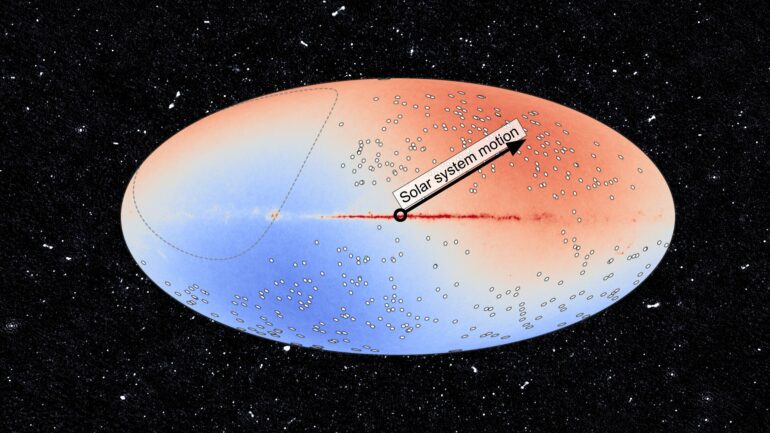Using MeerKAT data, an international team including astronomers from MPIfR (Bonn, Germany) has compiled the largest catalog of radio sources from any MeerKAT survey to date. With this catalog, they were able to make a measurement of the cosmic radio dipole, a cosmological effect that arises from the Earth’s motion through the universe, and provides an important test of our theories of cosmology at the largest scales.
The new catalog and accompanying scientific results of the study are described in a paper released on the preprint server arXiv, and have been accepted for publication in Astronomy & Astrophysics.
The new measurement demonstrates the value of the sensitive MeerKAT data, and shows that such deep data provide extremely valuable insights into the origin of the cosmic dipole effect.
Looking up at the sky at radio wavelengths, rather than the stars one sees predominantly galaxies that are extremely far away. Observing the radio sky provides an unobstructed window into the evolution of galaxies, black holes, and gas in the universe, and can also show what the universe looks like at the largest scales.
The MeerKAT Absorption Line Survey (MALS), powered by the outstanding sensitivity and imaging fidelity of the MeerKAT radio observatory in South Africa, has produced extremely sensitive images detecting close to a million radio sources from 391 telescope pointings.
It is the largest catalog produced by a MeerKAT survey thus far, one of only a handful of radio catalogs with a million or more sources. Due to its focus on depth rather than sky coverage, many sources have been detected for the first time.
“The depth and the expanse of this continuum catalog holds a unique position among modern radio continuum surveys. The public release will enable the community to address a wide range of issues associated with the evolution of galaxies and the universe,” says Neeraj Gupta, astronomer at the Inter-University Center for Astronomy and Astrophysics (IUCAA) and lead investigator of the MALS project.
To get to these deep images from the large amounts of raw data produced by MeerKAT, a sophisticated processing pipeline and data storage facility is maintained at the IUCAA in India. The images and catalogs were further analyzed and prepared for public release at the Max Planck Institute for Radio Astronomy (MPIfR) in Germany by Jonah Wagenveld, lead-author of the paper presented here.
This large catalog has enabled the MALS team to perform a measurement of the cosmic dipole—a subtle effect caused by motion of the solar system through the universe. This effect makes sources appear more numerous in the direction of that motion and less numerous in the opposite direction.
The direction and magnitude of the Earth’s motion through the universe was previously established by measurements of the cosmic microwave background. The magnitude of the cosmic dipole effect, however, which should be directly related to the velocity of that motion, has been found by many measurements to be much higher than predicted.
This suggested that the dipole might not just be caused by the motion velocity, but a true difference in the density of sources in different directions on the sky, something which should not happen according to the cosmological models.
Rather surprisingly, the new MALS measurement is aligned with the predictions. While it is not yet known why this is the case, it may be related to the design of the survey, covering small patches of sky to a very deep level rather than the larger but shallower sky coverage of other radio surveys. As a consequence, many faint “normal galaxies” are present in the deep catalog, undoubtedly influencing the dipole measurement.
“Measuring the dipole is an extremely important test of cosmology, and can tell us whether our fundamental assumptions about the structure of the universe are correct,” explains Jonah Wagenveld, astronomer at MPIfR and lead author of the paper.
The mystery, however, is far from resolved, and future larger catalogs, either from MALS using the lower frequency UHF band of MeerKAT, or future observatories will have to dissect these findings and resolve the tension.
“The consistent and automated processing was essential to have a good handle on subtle effects in the data which would adversely affect the accuracy of our measurements. This new survey is the stepping stone for future large-scale radio surveys, with the Square Kilometer Array and Deep Synoptic Array,” notes Hans-Rainer Klöckner, researcher at MPIfR who conceptualized the usage of MALS for dipole measurement.
This is the second of several radio continuum and spectral line data releases to come from MALS and making this data release has been a team effort. The MALS catalogs and images are publicly available at https://mals.iucaa.in. The MALS team is an international collaboration of researchers from around the world. The project is led by Neeray Gupta from IUCAA, India.
More information:
J. D. Wagenveld et al, The MeerKAT Absorption Line Survey Data Release 2: Wideband continuum catalogues and a measurement of the cosmic radio dipole, arXiv (2024). DOI: 10.48550/arxiv.2408.16619
Provided by
Max Planck Society
Citation:
Astronomers compile largest MeerKAT radio source catalog to date (2024, September 3)



